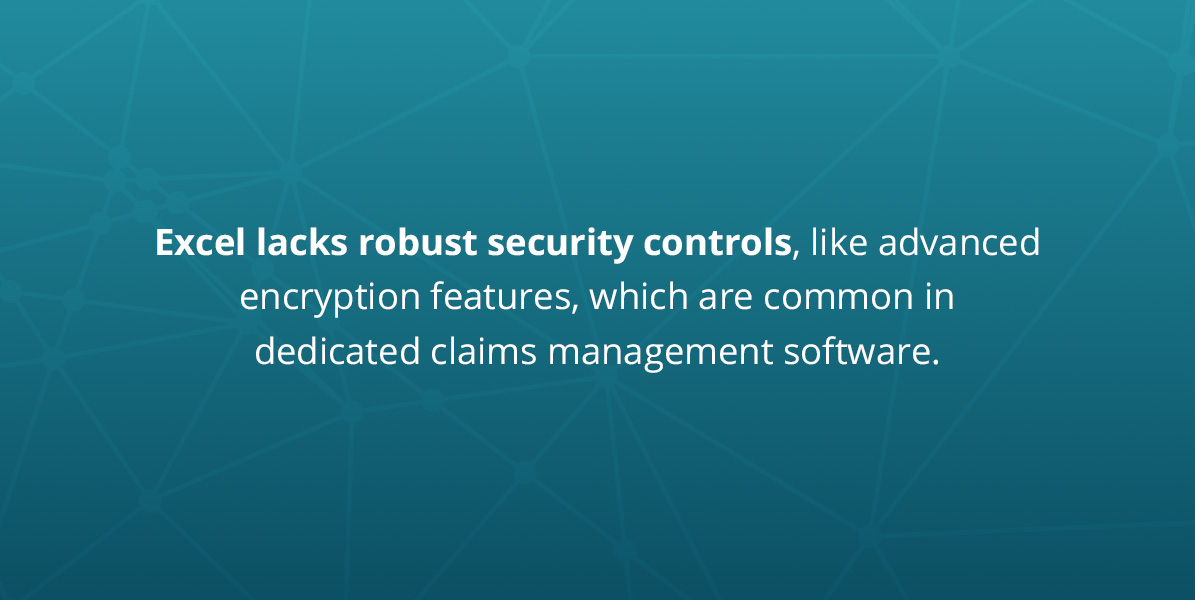Many organizations use Excel as a claims management solution. Consider that over 1.3 million companies worldwide use Office 365 and can access Excel. Despite its popularity, Excel has many limitations and poses risks as a self-insured organization’s primary claims management tool.
Here are reasons why Excel is not a suitable alternative to a database system or claims management software, followed by the benefits of adopting dedicated software.

1. Scalability Issues
As your organization scales and manages more data, it will need a system that can efficiently handle large data loads. Excel is not that system.
Unlike claims management solutions that have unlimited data storage out of the box, Excel has data limitations. It is not built to handle large or complex datasets efficiently, which can delay claims management processes or produce erroneous results.
Excel also does not support scalability because it is not a document management tool. Users cannot efficiently track and store claim-related documents, images or videos within Excel, hindering the ability to connect data to specific incidents, conduct an effective root cause analysis (RCA) and make meaningful policy decisions.
Lastly, the desktop version of Excel is weak at supporting team collaboration or optimizing workflows due to its lack of built-in workflow tools and integration capabilities.
2. Compliance Challenges
For many self-insured organizations, complying with Occupational Safety and Health Administration (OSHA) regulations is no small task. They must track work-related injuries and illnesses to satisfy the OSHA Form 300 requirements.
While some may use Excel as a spreadsheet and pricing tool, it is not the best option for capturing accurate incident-related data. With its limited integration capabilities, managers may not input data immediately following an incident, leading to a greater potential for errors or delays.
Excel also cannot create comprehensive audit trails, and tracking changes is a hassle. Users with editing access can easily delete or modify data in Excel. All of this can make it challenging for auditors to pinpoint the source of an error or validate data accuracy for reporting purposes.
There are better tools on the market designed specifically to enable real time, accurate data capture at the first notice of loss (FNOL) and streamline OSHA reporting requirements. Take APP Tech’s Cloud Claims, for example, which can help make OSHA recordable injuries a much easier process. Switching to Cloud Claims helps you stay on top of risk and regulatory compliance — making your job easier and helping you avoid costly mistakes.
3. Integration Issues
Self-insured organizations handle a lot of data and must communicate this information with insights to various sources efficiently. They require digital tools that enable smooth integration with stakeholder systems — if they want to streamline collaboration and prevent the need to rekey data.
Since Excel was primarily designed without the ability for diverse API integration, it does not support seamless connectivity with a variety of other systems without add-ons. With its inherent API limitations, it can be challenging to collaborate with related systems, leading to inefficiencies in incident reporting, risk mitigation, claims management and payment processing.
For example, Excel may be incompatible with other insurance platforms or tools and, therefore, unable to capture carrier loss runs, which are vital to learning about risks and developing mitigation strategies.
4. Steep Learning Curve
While some organizations hold onto Excel for its perceived ease of use, its lack of intuitive, purpose-built design can actually complicate claims management and impede the user experience.
Unlike dedicated claims management software, Excel does not present claims-related information in a meaningful, easy-to-digest way. It often requires users to adapt spreadsheets using complex formulas and techniques, which can be time-consuming or require a certain level of technical skill. Therefore, maximizing its capabilities can get complicated. Some employees may have difficulty learning Excel, particularly its data analytics features or formula creation. Without an intuitive user interface, organization-wide usage and adoption may be limited.
Claims management software, on the other hand, presents specific, claims-related data in an intuitive and easy-to-understand dashboard upon login, allowing users to gain insight quickly. Specialized software does not require digging through workbooks or scanning lengthy spreadsheets. Users can quickly change views with simple drop-downs.
Common Risks of Using Excel for Claims Management
Data accuracy is important in insurance because it can impact risk mitigation and reserve calculations. With that in mind, Excel’s limitations pose risks for self-insured organizations, particularly in the following areas:
Data Consistency and Management
Managing data and ensuring consistency can be difficult and time-consuming in Excel. As a spreadsheet program with limited automation and integration capabilities, Excel requires more manual input than purpose-built claims management software, increasing the risk of human error.
For example, while users can create formulas to automate calculations, they can also easily input inaccurate formulas, leading to countless and costly mistakes. According to a survey conducted in the U.K., 98 percent of office workers have seen an Excel-related error cost their employer money.
Excel is also known for its issues with version control. With Excel, users may create various versions of the same spreadsheet, leading to challenges in maintaining data integrity. For example, someone might edit an Excel spreadsheet simultaneously, leading to data loss or inconsistencies.
Lastly, Excel’s connectivity limitations may make users struggle to manage data centrally, necessitating manual data entry and increasing the risk of human error. Overall, limited data consistency can hinder efforts to conduct effective RCA, impacting the ability to identify and address risks. A centralized, purpose-built platform, by contrast, provides organizational transparency and more defined access control.
Security Concerns
Where security is a priority, Excel falls short. Excel lacks robust security controls, like advanced encryption features and access permissions, which are common in dedicated claims management software.
Excel also does not make it easy to coordinate access permissions on a granular level. Users typically select “read-only” or “edit” access options when sharing their files. Once a person has edit access, they can change any element in the spreadsheet. If the spreadsheet is shared without any restrictions, it can quickly lead to unauthorized access and leaking of sensitive data. Users may also share Excel files over unsecured channels.
Organizations must implement procedures to ensure data security and confidentiality while using Excel, which may be more complicated than if using more robust software.
Real-Time Reporting
Real-time reporting is essential in risk and claims management processes because it prevents delays between teams and enables risk managers to mitigate risks promptly. Although newer versions of Excel allow data entry in real time, it may not meet the demands of self-insured organizations in field applications.
For example, Excel is available in mobile versions, meaning users can enter data from anywhere. However, using a spreadsheet from a mobile device can be cumbersome, and the mobile version of Excel does not offer all the functionalities of the desktop version. As mentioned earlier, since Excel is not a document management tool, users are unable to attach incident-related documentation to spreadsheet data.
Excel is also not inherently built to distribute reports automatically, adding to an organization’s administrative burden and delaying decision-making and collaboration. So, while Excel may be used to capture real-time data in some instances, it is not designed to notify stakeholders of an incident automatically. The longer stakeholders are not aware of an incident, the longer risks may go unaddressed.
The Benefits of Specialized Insurance Platforms and Tools
Unlike Excel, claims management software is purpose-built for claims processing efficiency and consistency. It is intentionally designed to organize claims-related data, optimize and automate workflows, generate real-time reports, and reduce manual data entry. Claims management software is also created with more robust security controls to help organizations comply with privacy standards and reporting requirements.
Advantages of claims management software for self-insured organizations include:
Workflow Optimization
Claims management software streamlines data sharing to promote seamless collaboration. It also automates repetitive tasks and enables tailored workflows.
For example, Cloud Claims by APP Tech is built to coordinate claims processing while reducing administrative burden. It enables self-insured organizations to create customized, automated workflows that enhance claims and risk management efficiency.
To illustrate, your team can use Cloud Claims to automatically send notifications of incident or claim activity to key stakeholders at various stages in the claim life cycle. This saves employees from having to notify the appropriate parties manually, allowing stakeholders to be aware of new incidents in real time.
Customization Options
Customization allows organizations to tailor claims management software so it is relevant to specific needs and highlights meaningful insights. Cloud Claims features extensive customization options to support an organization’s unique requirements and simplify data management, including customizable drop-downs and, email templates and key performance indicators (KPIs). Customizable drop-downs allow management to tailor data fields and minimize manual data entry. Managers can centrally manage data and ensure accuracy and consistency throughout the organization.
Software customization also allows teams to treat data segments for incidents, claims, parties, bills and policies uniquely. Organizations can analyze each segment and generate focused reports to showcase specific areas, such as incident-related KPIs.
You can customize Cloud Claims in-house to suit your requirements best — no need to work with developers or undergo extensive training to tailor the system.
Cloud Benefits
Cloud-based solutions are designed to promote simple, streamlined and secure communications. APP Tech’s Cloud Claims is securely stored in the cloud, enabling a single point of truth across various policies and data records without requiring spreadsheet coordination. As team members submit incident details to Cloud Claims, management can access this information from anywhere at any time and gain a comprehensive view of their organization’s risk health. Cloud Claims also offers unlimited file storage, enabling enhanced scalability and team coordination.
Lastly, cloud-based solutions like Cloud Claims offer multiple layers of security, including industry-approved encryption features. As a software as a service (SaaS) provider that maintains a SOC 2 Type II annual report, we hold ourselves accountable for protecting our customers’ data, providing robust security and implementing automatic system upgrades.
Mobile Access
Platforms that allow seamless mobile use do more than offer convenience — they enable organizations to proactively mitigate risks and resolve incidents before employees file claims. Cloud Claims is built to allow accessibility from any device, enabling FNOL from the field. This allows claimants or supervisors to submit FNOL data to Cloud Claims immediately after an incident at the site, allowing for more accurate and timely data capture.
Claims or risk managers can access FNOL data from their phone, tablet or laptop to make prompt decisions. If a claim is filed, claimants and other stakeholders can track the claim status through a portal on their mobile devices, reducing the need for back-and-forth communications.
User-Friendly Dashboards
Software is only valuable if team members use it. Thus, it is important to have an intuitive system. Cloud Claims was designed to allow users of various skill levels to gain insights from data and generate reports quickly, encouraging adoption and enthusiasm. The user-friendly dashboard features a straightforward, drag-and-drop configuration for easy customization. Users can arrange the interface to provide instant insight into selected claim activity upon logging in. For example, risk managers can instantly view loss trends, claim status or other key information they want to see in their dashboard.
Simplified and Robust Reporting
Unlike Excel, claims management software is specifically designed to assist self-insured organizations in collecting and analyzing claims and risk data so they can quickly digest information and improve decision-making with actionable insights. Cloud Claims simplifies data analytics and reporting with turnkey reports for common applications like loss runs. Its drag-and-drop features, such as the ability to group by dragging column headers, allow quick and easy customization. Its intuitive, drag-and-drop functionality also enables ad hoc graphs for fast analysis of live data and rapid decision-making.
Incident-Based Design
Traditional approaches to claims management focus on data analysis after a claim is filed. By contrast, an incident-based approach to claims management emphasizes accurate and timely data collection at FNOL to support effective root cause analysis. It enables teams to learn from near-misses, develop proactive risk mitigation and intervene before a claim is filed.
Cloud Claims is uniquely built with an incident-based architecture to streamline incident reporting and promote efficient risk management. With Cloud Claims, stakeholders can upload photos, videos and documents from the field using their mobile device. The software integrates seamlessly with stakeholder systems and notifies the appropriate parties of incidents automatically. Additionally, stakeholders can easily track multiple claims from a single incident to gain insight into the underlying cause and its financial impact.
Cloud Claims does not require re-keying the same information for different claims connected to the same incident. Other features, like the ability to organize documents by tags or email them to stakeholders directly from Cloud Claims, streamline communication.
Try a Modern Approach to Policy Management Systems
Insurance software is built with efficiency-enhancing features and without the limitations of Excel. If your organization is ready to elevate your claims and risk management processes, consider implementing a purpose-built solution like Cloud Claims.
We can help your organization seamlessly transition out of Excel and into Cloud Claims with tailored onboarding and quick deployment. With our 100 percent successful implementation rate, you can be sure the transition will be seamless. Contact us today to start a conversation or schedule a tailored Demo.










